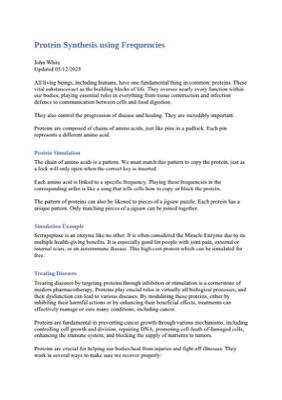Protein Audio
Click the links above to directly access the audio files.
There is no charge for the audio on this website. The audio files are being gifted to humanity. There is no copyright.
The audio files may be freely shared by everybody. Additionally, no patents for the proprietary software tools and methods have been, nor ever will be, applied.
To safeguard against nefarious use, the software creation tools and creation method cannot be provided. Please don't ask.
Life as we know it is built upon intricate chains of amino acids, which assemble into proteins, peptides, DNA, and RNA - the fundamental components of all living organisms. Each of these molecules plays a critical role in the body, from building tissues to regulating cellular processes. An innovative frontier in bioenergetic science explores the potential to simulate or inhibit amino acid sequences using audio frequencies. By translating the sequence and structure of these biomolecules into their unique acoustic signatures, this approach offers a fascinating intersection of biology and sound therapy.
Each amino acid in a peptide or protein sequence can be assigned a distinct tone, determined by its mono-isotopic mass. These tones create a precise auditory "signature" for the molecule. When played, this sequence generates a propagation wave that resonates through the protein’s backbone, effectively interacting with its structure and function. This resonance has the potential to influence biological processes, paving the way for a novel approach to addressing various health challenges.
This concept is built on the groundbreaking work of visionary scientists, such as Joel Sternheimer, who patented methods that explore the relationship between sound and protein synthesis, identifying the resonant frequencies of amino acids. Sternheimer showed that each amino acid in a protein sequence generates a specific quantum vibration based on its molecular properties, such as its mass and bond structures. These vibrations can be translated into unique frequencies that correspond to musical tones. Thus, a protein sequence can be represented as a "melody," where each amino acid contributes a specific note.
Sternheimer's research highlights that the synthesis of proteins - a process called translation - is influenced by quantum phenomena. During translation, as ribosomes assemble amino acids into proteins, the vibration of each amino acid propagates along the growing protein chain. This propagation wave creates a specific resonance that can influence the folding and function of the protein.
Sternheimer posited that playing the "melody" of a protein (i.e., the corresponding sound frequencies of its amino acids) could resonate with the protein’s quantum state. This resonance could theoretically either enhance or inhibit the protein's synthesis, depending on the frequencies used.
By playing the resonant frequencies associated with a beneficial protein, one could potentially encourage its synthesis in the body. For example, frequencies corresponding to proteins involved in tissue repair or immune response could accelerate healing or enhance immunity.
Conversely, harmful proteins, such as those produced by viruses or cancer cells, could be suppressed by introducing frequencies that interfere with their synthesis.
Sternheimer’s work laid the groundwork for others, like Irena Cosic, who developed the Resonant Recognition Model (RRM), which uses electromagnetic frequencies rather than sound waves to modulate protein activity. Together, these theories suggest that frequency-based therapies could become a significant tool in future medicine.
Joel Sternheimer’s theory opens the door to a fascinating realm where biology and music converge, offering the potential to use sound as a tool for health and healing. As technology and understanding of quantum biology advance, the practical applications of his ideas may come closer to realization.
The audio files provided above extend foundational discoveries. They are designed to take protein synthesis and suppression to new heights, offering a practical and innovative tool for influencing biological pathways. Whether it’s to stimulate desired processes or inhibit harmful ones, these audios represent a promising advancement in health and wellness.
By harnessing the intrinsic sound of life’s building blocks, we enter a realm where biology meets frequency, unlocking the potential to harmonize the body in ways previously unimagined.
Disclaimer:
The audio files provided on this website are for personal experimental use only. John White and Cancer Clinic NZ Ltd (hereafter collectively referred to as CCNZ) ARE NOT RESPONSIBLE for any damage or injuries of any sort or form that may be sustained by any person or persons, any animal, or to any equipment or any other thing or things. The audio files created by CCNZ have not been studied or approved by any governmental or medical agency or inspection service. No medical claims are made for, nor implied by CCNZ.
You are advised to always consult with your physician or other health care professional at any time should you have or think you might have a health problem. Please check with your physician or other health care professional before starting any diet, exercise, taking over-the-counter (OTC) medications or supplements and especially before taking any prescribed medication. Never stop taking any prescribed medications without first consulting your physician. Please seek the advice of your doctor or healthcare professional before listening to the audio files on this website.

